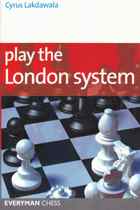Play the London System
Cyrus Lakdawala

San Diego IM Cyrus Lakdawalas first book, Play The London System, is the rare opening work aimed at a wide audience that succeeds. Club players will appreciate the 92 model games that are the centerpiece of this book. Carefully annotated with lots of explanatory prose these games are accessible to players as low as 1600 and yet this is by no means a book aimed solely at amateurs that avoids examining Blacks most promising tries.
IM Lakdawala has laid out his book as follows:
Contents:
Bibliography 4 Introduction 5 1 1…d5 with an early…e6 10 2 1…d5 without an early …e6 40 3 London versus Queens Indian 75 4 London versus Grünfeld 107 5 London versus Reversed Réti 132 6 London versus Kings Indian 153 7 London versus Dutch 178 8 London versus Benoni 198 9 Other Lines 213 10 An Inconvenient Move Order 230 Index of Variations 246 Index of Games 252
The first thing one notices when looking at the index of games is some of the players featured multiple times on the White side particularly Gata Kamsky and 24-year-old Boris Grachev who is zeroing in on 2700. The perception of the London as an opening played only by gray-haired club players is clearly out of date. So is the notion that the London only leads to boring lifeless positions and that Whites play is by rote.
One Anti-London system recommended for Black in several repertoire books is the line 1.d4 Nf6 2.Nf3 g6 3.Bf4 Bg7 4.e3 0-0 5.Be2 d6 6.h3 c5 7.Nbd2 Nc6 8.c3 Be6 (planning …Qb6 but not allowing Qb3 in reply). Here Lakdawala recommends Grachevs paradoxical 9.dxc5! giving up the center to leave Blacks Queen without a comfortable square (a White Rook is coming to the d-file.
Play The London System is written from Whites point of view but that doesnt prevent the author from examining challenging lines for Black like 1.d4 Nf6 2.Nf3 g6 3.Bf4 Bg7 4.e3 d6 5.Nc3 0-0 6.c4 Nfd7 or 1.d4 Nf6 2.Nf3 g6 3.Bf4 Bg7 4.e3 d6 5.h3 0-0 6.Bh3 Nfd7 where the second player aims for a quick …e5 and …f5.
The different White move orders presented in the last paragraph reflect a continuing battle in the London where White and Black tinker with their play in the first few moves to steer for something they like which will make their opponent uncomfortable. This tinkering can come very early! Lakdawala prefers to meet 1.d4 Nf6 with 2.Nf3 but 1.d4 d5 with 2.Bf4. The reason for this is that the author believes (and he is not alone) that 1.d4 d5 2.Nf3 Nf6 3.Bf4 c5 4.c3 Qb6 5.Qb3 Nc6 6.e3 c4 7.Qc2 Bf5 is not very promising for White. By meeting 1.d4 d5 with 2.Bf4 White can delay the development of his King Knight advantageously. This is all well and good, but as Lakdawala writes in a chapter titled “An Inconvenient Move-Order what does one do after 1.d4 Nf6 2.Nf3 d5 seemingly tricking White. His answer is 3.c3 c5 4.dxc5 as used successfully by Kamsky to defeat Karjakin at Wijk aan Zee 2009.
Play The London System covers almost every possible setup against the London including 1.d4 b5 and 1.d4 d6 2.Nf3 Bg4, pointing out as with Kamskys 4.dxc5 given above, that Londoners can strengthen their system if they are willing to go outside it when the occasion requires. My only reservation with this book, albeit a small one, is that nothing is given against 1.d4 g6 or 1.d4 d6 intending …g6. This move order, offering to play the Modern, probably requires White to play 2.e4 (maybe adopting a setup with Nf3 and c3) as allowing Black a quick …e7-e5 is not advised. Space limitations may have precluded the inclusion of what is admittedly a pure Modern Defense variation.
Highly Recommended
